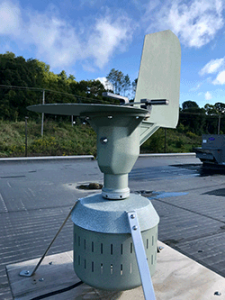The Madness Behind the Mold Count

A green air sampling machine sits atop the Allergy Associates of La Crosse building, turning with the wind and vacuuming in air to trap pollen and mold samples on a greased slide. Tony Kavanaugh, medical laboratory technician at Allergy Associates, climbs up to the roof nearly every morning to retrieve the sample for the day. He grabs the slide within the machine and heads to his microscope, where he manually counts the number of mold and pollen spores on the slide.
 After counting the particles on the slide, he looks at recent pollen counts, historical data, and weather conditions to determine the allergy symptom index for the day, whether it is low (minimal allergy symptoms), medium, high or very high (severe allergy symptoms). This data is posted to the Allergy Associates website and is provided to local media outlets, as well as the National Allergy Bureau to be distributed nationally, so that the community knows what to expect for the day, allergy-wise.
After counting the particles on the slide, he looks at recent pollen counts, historical data, and weather conditions to determine the allergy symptom index for the day, whether it is low (minimal allergy symptoms), medium, high or very high (severe allergy symptoms). This data is posted to the Allergy Associates website and is provided to local media outlets, as well as the National Allergy Bureau to be distributed nationally, so that the community knows what to expect for the day, allergy-wise.
While Tony makes it simple for us to know what to expect, a few people have asked about how the actual count from the slide relates to the symptoms someone may feel. The confusion stems from, for example, on a day in August, mold had almost 100x the amount of spores compared to ragweed pollen, but mold was considered medium for symptoms and pollen was considered high. Why is the number of mold spores so high compared to pollen, though pollen has a higher symptom index? Luckily for us, we have an expert to answer these questions.
When the sample is collected
The first thing to understand is that the mold and pollen count Tony is reporting today is actually from yesterday. The sampling machine collects particles for 24 hours, from 8 a.m. one day to 8 a.m. the next, therefore the counts are not in real time. “The count reported on 8/23 represents the air collected on 8/22. When setting the symptom index, several factors are considered including yesterday’s count, recent counts, historical average counts, and forecasted weather conditions,” Tony elaborates, “15,000 mold spores were reported on 8/23 and that was twice as high as recent counts. The weather forecast for 8/23 included cooler temperatures. Since the 15,000 collected on 8/22 was an outlier, mold spore counts were expected to be lower on 8/23. This outlier is a good example of how the air sample is not exactly the same as the air an individual person would encounter.” As this example shows, understanding the level of symptoms goes beyond just comparing a number to a graph — see a grid of the common allergen seasons from 2003-2015.
Though pollen or mold counts may give a general idea of symptoms, the level of allergy symptoms an individual feels is really based off of their unique daily activities. Tony says, “The air sample is not exactly the same as the air an individual person would encounter.” On 8/22 when the mold count was oddly high, Tony explains that, “someone nearby could have been pulling weeds, or harvesting vegetables, or doing something to stir up some mold and the air carried this mold to our air sampler. In the same way, if a person rolls in a field of ragweed, they would be exposed to more ragweed pollen than our air sampler.”
The types of mold in the air
The symptom index is also based off the individual molds or pollen found in the air and each individual mold and pollen has different levels of symptom severity. To elaborate, Tony explains that alternaria is a strong allergen, where a count of 100 is high, compared to cladosporium, where counts are regularly over 2,000. The same goes for pollen. The count has remained a steady 100 throughout August, but Tony explains, “100 weed pollen had a low symptom index earlier in August because that 100 contained no ragweed. Now the weed pollen count is still 100, but because most of the pollen is ragweed, the symptom index is high.”
The sampler
Finally, Tony explains that one of the reasons mold counts are so much higher than pollen is due to the new sampling instrument. “The new sampler uses a different technique than our previous sampler which catches more mold spores. A mold spore count of 3,000 was high with the old sampler whereas 3,000 is a low count using the new sampler,” he says. With the new sampler came a new set of criteria to base the symptom index off of.
Watching the mold and pollen counts is beneficial for allergy sufferers in order to avoid and treat the symptoms of their allergies. Many sufferers may have a difficult time understanding the different types of molds they may have been tested or treated for. Allergychoices has put together a handy mold guide to help sufferers identify the different types of mold, where they appear, and when they’re most common. Download a copy of the guide. Allergy drops have helped individuals rid themselves of symptoms all together. Learn more about allergy drops.
By Taylor Pasell, Allergychoices
